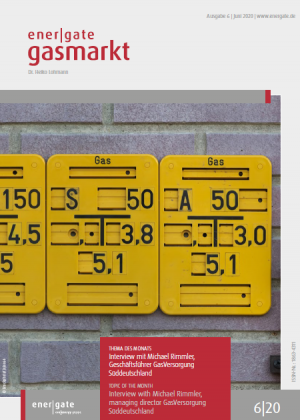Topic of the month: Interview with Michael Rimmler, managing director GasVersorgung Süddeutschland
The last time ener|gate Gasmarkt spoke with Michael Rimmler, the managing director of Gas- Versorgung Süddeutschland (GVS), was February 2019. At the time, the focus was on the development of the sales company business and the future perspectives of the sales company. The plan was to extend power sales and services. At the beginning of May, this publication talked once again with Mr Rimmler. Naturally, a large part of the discussion was around the Covid-19 crisis and its impact on the GVS business. The surprising takeaway: While the impact on the business is rather small, the crisis has some positive aspects for the organisation.
ener|gate Gasmarkt: Mr Rimmler, what is the impact of the Covid-19 crisis on your business?
Mr Rimmler: First of all, the corona crisis means for us a big step forward in applying digital media. ener|gate Gasmarkt: What does “big step forward” mean, and what are the fundamental changes?
Mr Rimmler: What does „big mean“. In the past, we rarely used web conferences. Since March 11, all our staff has been working from home. Since then, we have switched completely to web conferences. From the start this has worked very well and smoothly. That really changed my mind.
Market developmentNetwork Development Plan
At the beginning of May, the TSOs’ association FNB Gas published the consultation document for the Network Development Plan (NEP) 2020 to 2030. On May 13, the TSOs’ consultation workshop with further explanations took place (of course only virtually). During the workshop, BNetzA provided a first assessment of the TSOs planning. Strong increase in willingness to invest The total investment planned by TSOs over the ten years horizon is 8.5 billion euros compared to 6.9 billion euros from the NEP 2018 to 2028 (and 2.2. billion euros from the first NEP 2012). What is driving the appetite for more investments?
• Additional capacity to enhance the supply in southwest Germany and to connect planned new back-up power plants. The TSO from Baden- Wuerttemberg, terranets bw, intends to invest an additional 700 million euros. The TSO revived the historic pipeline project, Süddeutsche Erdgasleitung (SEL) as a new backbone for gas supplies in Baden-Wuerttemberg. At the beginning of the millennium, Ruhrgas and Wingas (it was in the pre-unbundling time) intended to build a pipeline from the German-Austria border point Burghausen across Bavaria and Baden-Wuerttemberg to Lampertheim, a pipeline hub in the south of Hesse. Until the end of 2026, terranets wants to build the segment between Lamperthim and the Bavarian border. This project alone will cost 422 million euros.
• The network extension (without the direct connection pipes) for the three planned LNG terminals Brunsbüttel, Wilhelmshaven and Stade will be partly responsible for around 400 million euros of investments (the investment is not only caused by additional entry-capacity from the terminals). The direct connection lines for the terminals need an extra 200 million euros investment.
• The provision of additional H-gas capacity for the Netherlands. Unfortunately, the document has no transparent overview that allocates extension projects to this new capacity provision. Therefore, it is difficult to assess the cost.
Framework conditions
The discussion on the regulation of hydrogen networks in Germany has reached the next level. BNetzA launched a consultation on the need and the potential design of such a regulation. On roughly 100 pages, the authority provides a comprehensive survey of the status quo of the commercial and regulatory environment for hydrogen, and outlines several options for the regulation and related issues that must be decided. With 12-page questionnaire (okay, the questions are on five pages), BNetzA wants to get feedback from stakeholders on the different aspects of the whole topic.
BNetzA favours a new separate act, a Hydrogen Infrastructure Act (WiG). Alternatively, a new chapter on hydrogen might be added to the German Energy Law (EnWG). In the paper, BNetzA argues that simply adding hydrogen to the gas definitions in the EnWG and the relevant ordinance provisions does not do justice to the complexity of the issue. Several associations, among them FNB Gas, the association of the TSOs, propose such a quick fix of the regulatory framework to integrate hydrogen into the gas network regulation. What are the reasons for the perceived complexity by BNetzA?
Framework conditions
The discussion on the regulation of hydrogen networks in Germany has reached the next level. BNetzA launched a consultation on the need and the potential design of such a regulation. On roughly 100 pages, the authority provides a comprehensive survey of the status quo of the commercial and regulatory environment for hydrogen, and outlines several options for the regulation and related issues that must be decided. With 12-page questionnaire (okay, the questions are on five pages), BNetzA wants to get feedback from stakeholders on the different aspects of the whole topic.
BNetzA favours a new separate act, a Hydrogen Infrastructure Act (WiG). Alternatively, a new chapter on hydrogen might be added to the German Energy Law (EnWG). In the paper, BNetzA argues that simply adding hydrogen to the gas definitions in the EnWG and the relevant ordinance provisions does not do justice to the complexity of the issue. Several associations, among them FNB Gas, the association of the TSOs, propose such a quick fix of the regulatory framework to integrate hydrogen into the gas network regulation. What are the reasons for the perceived complexity by BNetzA?
Framework conditions
The discussion on the regulation of hydrogen networks in Germany has reached the next level. BNetzA launched a consultation on the need and the potential design of such a regulation. On roughly 100 pages, the authority provides a comprehensive survey of the status quo of the commercial and regulatory environment for hydrogen, and outlines several options for the regulation and related issues that must be decided. With 12-page questionnaire (okay, the questions are on five pages), BNetzA wants to get feedback from stakeholders on the different aspects of the whole topic.
BNetzA favours a new separate act, a Hydrogen Infrastructure Act (WiG). Alternatively, a new chapter on hydrogen might be added to the German Energy Law (EnWG). In the paper, BNetzA argues that simply adding hydrogen to the gas definitions in the EnWG and the relevant ordinance provisions does not do justice to the complexity of the issue. Several associations, among them FNB Gas, the association of the TSOs, propose such a quick fix of the regulatory framework to integrate hydrogen into the gas network regulation. What are the reasons for the perceived complexity by BNetzA?



